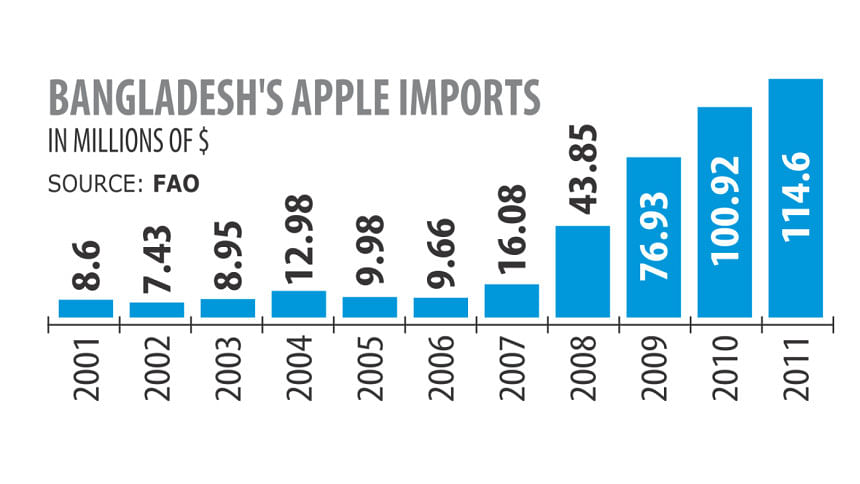Bangladesh emerges as robust market for apples

Bangladesh has emerged as a robust market for apple producers due to rising demand for the imported fruit in the absence of local production, said the United States Department of Agriculture.
The country’s import of apples was 140,000 tonnes a year on average between 2009 and 2014 and the value grew from $68.8 million to $103.5 million, the USDA said.
“While Bangladesh is generally viewed as a price-sensitive market, there are niche segment opportunities. The middle to upper class consumers are gradually demanding more diversified foods, including imported fruits such as fresh apples,” the USDA said in a recent report, Robust Apple Export Market: Potential for Growth.
The USDA, citing industry sources, said it took approximately one month to sell 15 to 20 containers of apples in 1991. Today, an estimated 21 containers are sold per day.
The Food and Agriculture Organisation’s data also shows a rising trend in apple import by Bangladesh. Import of the fruit grew more than four times to 142,886 tonnes in 2011 from that in 2001, according to the FAO.
The value of imports rose 13.55 percent to $114.6 million in 2011 from the previous year, according to data from FAO
“Demand for fresh apples is robust in both urban and rural markets, especially with the middle and upper income consumers,” said the agency. Dhaka is the consumption hub and absorbs around 30 percent of the imported fruit while Chittagong consumes 15 percent.
Modern retail outlets, high-end hotels and restaurants, fuel this rising demand but the unorganised sector, including push carts, street vendors, corner shops and weekly markets, constitutes the majority of food retail sales,” it said.
The report pointed out that the top 20 percent of the population in terms of income accounts for 41.4 percent of total consumption.
The USDA said a variety of tropical and sub- tropical fruits are grown in Bangladesh but the country produces no apples.
Bangladesh imports the fruit from China, India, South Africa, Brazil, New Zealand, and Argentina. China and India are the largest suppliers of fresh apples, constituting 68 and 9 percent of total market share here, because of geographical proximity.
From 2009 to 2014, imports from countries such as South Africa and Brazil have increased, at a compound annual growth rate of 2.9 and 4.1 percent, according to the report. “Because of this demand, the US industry should consider exploring potential market opportunities for all US apple varieties, especially in more urbanised markets such as Dhaka and Chittagong,” said the USDA.
The USDA said high tariffs generally prohibit higher quality, more expensive fruits from entering the Bangladesh market, although as incomes rise, demand for higher quality fruits will also grow.

 For all latest news, follow The Daily Star's Google News channel.
For all latest news, follow The Daily Star's Google News channel. 



Comments